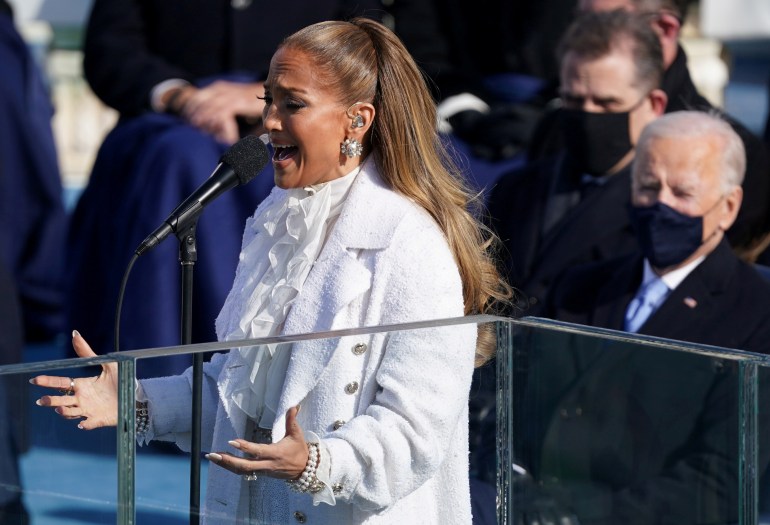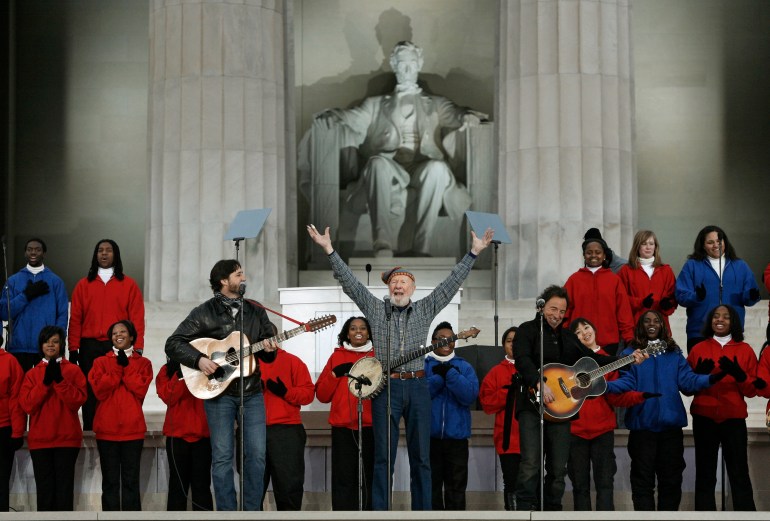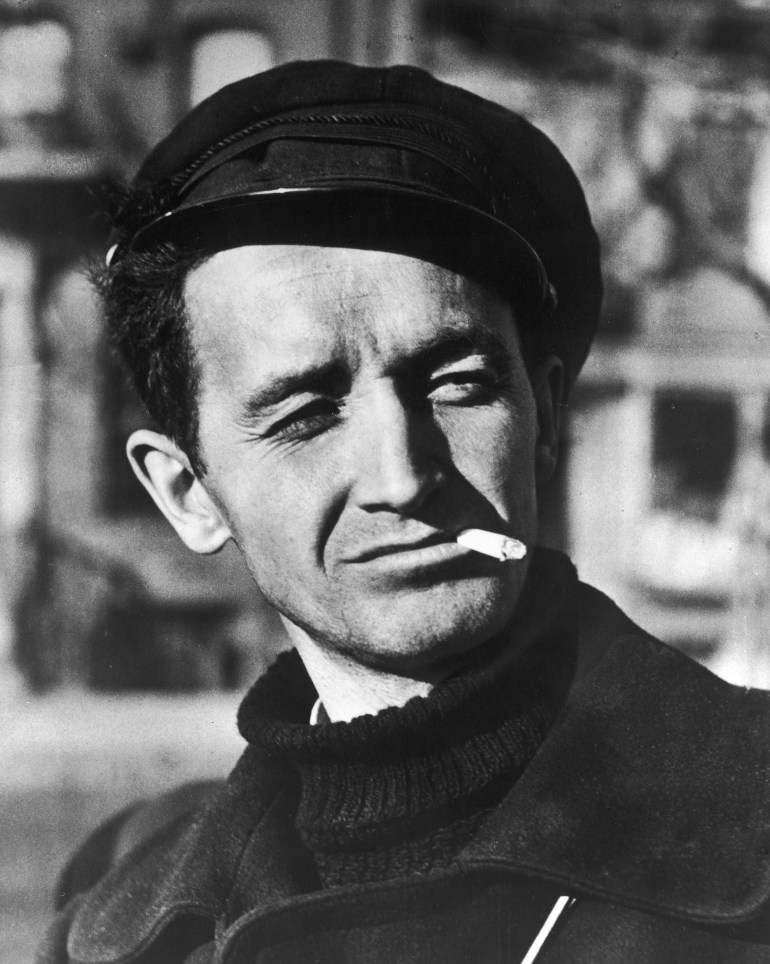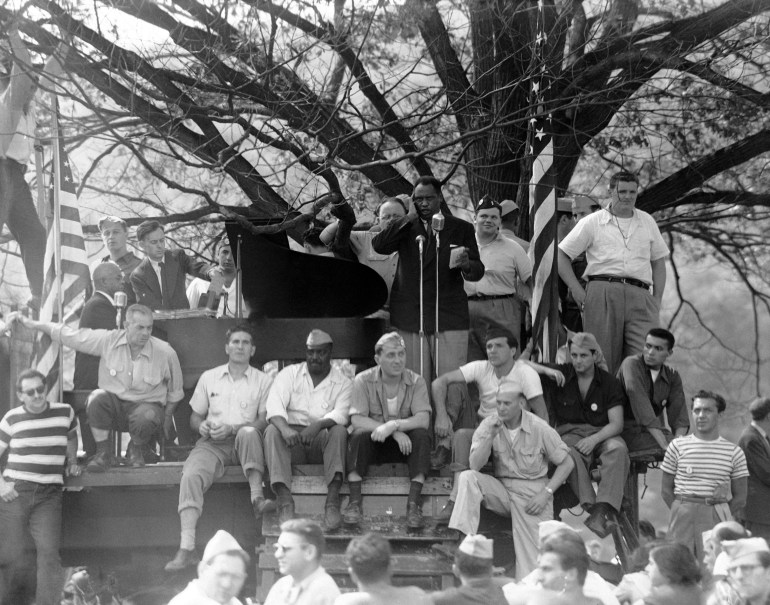This Land Is … whose land?: The history of Woody Guthrie’s song
JLo’s performance of the folk singer’s This Land Is Your Land at Joe Biden’s inauguration was meant to promote ‘unity’, but the song has been criticised as a ‘settler anthem’ that ignores US violence against Indigenous people.

Several minutes into US President Joe Biden’s inauguration ceremony, on the heels of an impassioned rendition of The Star Spangled Banner by her fellow pop superstar Lady Gaga, Jennifer Lopez stepped up to the podium and began singing lyrics many Americans learn in schools and churches:
This land is your land
Keep reading
list of 3 itemsOccupying Alcatraz: The spark that lit the US Red Power movement
From lynchings to the Capitol: Racism and the violence of revelry
This land is my land
From California to the New York island
From the Redwood forest to the Gulf Stream water
This land was made for you and me
Few songs besides Woody Guthrie’s This Land Is Your Land, it would seem, could better embody the theme of “unity” with which President-elect Biden had been attempting to dissipate the climate of bullying and cruelty cultivated by the Trump administration.
But throughout Wednesday afternoon and the days that followed, a steady stream of social media posts criticised the use of the song, with its apparent disregard for the fact that it only became possible to call this land yours and mine because of acts of violence against its earlier occupants, the Indigenous people of what we now call North America.
That Guthrie is an icon of the US left, a man famous for songs calling for justice for the disempowered and exploited, carried no currency; “The inauguration began by JLO singing a song celebrating stolen land and Indigenous genocide,” wrote Lower Brule Sioux historian Nick Estes on Twitter, where the song was also called a “settler anthem” and “the epitome of Indigenous erasure”.

I spent the past seven years researching and writing Woody Guthrie: An Intimate Life, a biography focusing on how the singer lived as a son, lover, father, psychiatric patient, and disabled person while maintaining his staunch leftist principles in the increasingly reactionary atmosphere of the post-war US. In my deep research into his private papers, I found a brilliant, complicated and flawed human being whose struggle to understand both his personal world and his place in history made me admire him more deeply than before I began the project.
That said, I agree with the critics. His most famous song erases the true history of this continent, the fundamental violence and brutality of settler colonialism that made it possible for people of European ancestry to live here – facts that many white citizens of the US, across the political spectrum, would prefer not to consider. In the form in which most people encounter it, This Land Is Your Land replaces this actual past with an idealist fantasy of the “land” as an innocent place whose expanse and varied landscapes reflect Americans’ glorious capacity to come together across our differences.
The fact is, though, that Woody Guthrie would have despised any use of the song as a feel-good, ahistorical call for unity. Initially written in 1940 as a retort to Irving Berlin’s jingoistic God Bless America, Guthrie’s song is a scathing condemnation of the very idea that land can be owned, treated as property. In a rarely aired verse of the original lyrics, a sign reading “private property” interrupts the wandering minstrel’s cross-continental stroll. But the disturbance is only momentary, for the singer quickly notes that “on the other side, it didn’t say nothing/That side was made for you and me”. And, in another little-known verse, the singer witnesses starving people lined up at a soup kitchen, leading him to shift the refrain to a question: “Is this land made for you and me?” Notably, at an event celebrating Barack Obama’s first inauguration, former Guthrie colleague Pete Seeger and Guthrie heir Bruce Springsteen included these verses in their performance of the song.

In fact, once you have read the song’s lyrics in their entirety, the title phrase sheds all quasi-Kumbaya resonances and becomes what Guthrie meant it to be: a defiant, deeply radical statement of opposition to capitalist exploitation. The song’s words are critical and fierce, not cosy and reassuring: This land is your land, it declares to its listeners, not the land of the people who, according to market logic, own it, hold the deeds to it, exploit it for profit. Land is not a commodity. Those deeds are fictions, and the owners are, essentially, thieves.
Still, even this expanded – some would say accurate – account of the song’s politics does not refute the claims of Indigenous people and their allies. Even if the song’s intended message rejects the predations of capitalism and the ownership of land – which incidentally brings it closer in line with many Indigenous cultures’ understanding of people’s relationship to the land on which they live – even if, as I hear the song, it is not nationalist or even patriotic, This Land Is Your Land still neglects to mention the history that made the collectivist stroll it narrates possible for people of European descent, and that is a big problem, perhaps especially in the work of an artist committed to social justice.
As the Abenaki writer and musician Mali Obomsawin put it in a trenchant 2019 essay on the song’s implications for Indigenous people: “By critiquing ‘This Land Is Your Land,’ I don’t mean to imply that Guthrie himself promoted conquest, but the song is indicative of American leftists’ role in Native invisibility. The lyrics as they are embraced today evoke Manifest Destiny and expansionism … When sung as a political act, the gathering or demonstration is infused with anti-Nativism and reinforces the blind spot. Moreover, my critique is aimed at the nation-state of America, which teaches ignorances about American history so robust and deep-seated that even our society’s most inclusion-oriented activists struggle to transcend them.”
Key here is the notion of the “blind spot”. The song affirms what the scholar Mark Rifkin calls “settler common sense”: the privilege of those of us descended from settlers to look away, to forget both this history and the very much present and continuing lives of Indigenous people on this continent, and to nonetheless be taken seriously as an intellectual, politician, or social justice activist. As Obomsawin notes, this tendency runs through everything from cheering for professional sports franchises with names like “Indians” to calling the US a “nation of immigrants”.
Part of the point Obomsawin and Rifkin are making is that most white and other non-Indigenous people do not actively decide to ignore this part of history. Rather, as ignorance is passed down through the generations, resources that would unsettle it are simply not readily available, even in the classrooms of well-meaning educators and in attempts to heal a damaged nation like the Inauguration ceremony. And this scarcity of resources is reaffirmed when a song like This Land Is Your Land is sung, especially in its deformed, defanged version. As a result, as Obomsawin writes: “Ignorance is passively consumed and passively reproduced, cinching Native invisibility.”

For what it’s worth, however, Guthrie was someone who, throughout his life, sought to counter the myopia of his education and upbringing – including his privileges as a white person. His father, a civic leader in the town of Okemah, Oklahoma, was a self-proclaimed white supremacist, suspected to have taken part in the lynching of Laura Nelson, a Black woman, and her teenaged son L D the year before Woody was born. Racism was simply a given among white people in Oklahoma, which, before becoming a state in 1907, had been the final destination for Indigenous nations forcibly displaced from the Deep South, and which, after the collapse of Reconstruction, saw a large influx of African Americans hoping to found a Black homeland in its territory. Atrocities like the Nelson lynching were a direct response to these ambitions and to the vitality of the many all-Black towns that lasted into statehood.
In the early years of his professional career, in the late 1930s, Guthrie sang at least one racist song on the radio and drew anti-Black caricatures in his notebooks, even as he simultaneously wrote songs in support of dust bowl refugees and migrant workers. But as he learned more about the insidious ways power operates across race and class, collaborated with Black musicians, and became more familiar with the work of Black artists and activists, his views shifted drastically. In the early 1940s, he wrote a seven-minute song about Harriet Tubman, praising the fugitive leader for instigating organised, militant, armed resistance to slaveholders. In 1949, he was among the audience members of a Paul Robeson concert attacked by a racist mob as police looked the other way and, in some cases, directed concertgoers toward gauntlets of stone-throwers. He devoured the screed that Robeson and other Black radicals presented to the United Nations in 1951, We Charge Genocide, which called police brutality against African Americans a state-sponsored form of lynching. Indeed, he wrote songs based on some of the specific cases of police violence against Black men and women documented in its appendices.

Guthrie’s personal papers and some published material show that he held similar feelings of solidarity with Indigenous people. He could occasionally lapse into romanticism, as when he recalled witnessing the singing and dancing of people from the Creek Nation as a child. But in stage patter from one of his few recorded concerts, he also explicitly lamented how his displaced Indigenous neighbours in Oklahoma were assigned land believed to be deficient in resources of value, only to be “cheated” out of it, “or worse”, upon the discovery of oil. At one point, making notes for a project about a series of radical martyrs, he planned to write a ballad about Mangas Coloradas, the 19th-century Apache tribal chief famous for his especially forceful, even deadly resistance to white settlement in the Southwest. He had clearly been paying attention, through reading or conversation with more enlightened comrades or both. Consequently, he was able to dislodge many of the conventional assumptions making up the slippery white supremacy embedded in settler common sense.
I should note that the social media postings of Inauguration Day were far from the first eruption of criticism of This Land Is Your Land by Indigenous people; they reflect a decades-long critique. The non-Indigenous, especially white Americans, should listen to these voices closely. We should recognise how the song’s words sound to many Native Americans, and act accordingly – whether that means singing it with a prefatory comment, singing the suppressed verses, not singing it at all, or some other creative and empathic option.
We should not let our sentimental attachments to the song cause us to strike a defensive pose. A man who routinely acknowledged his flaws and limitations throughout his relatively brief life, Guthrie tried to see the world in ways that challenged convention, that questioned the accepted, common sense of things, and that took no hierarchy for granted. Indigenous critiques of the song’s erasures are vital to the pursuit of justice for all, and evidence suggests that Guthrie himself would have agreed.